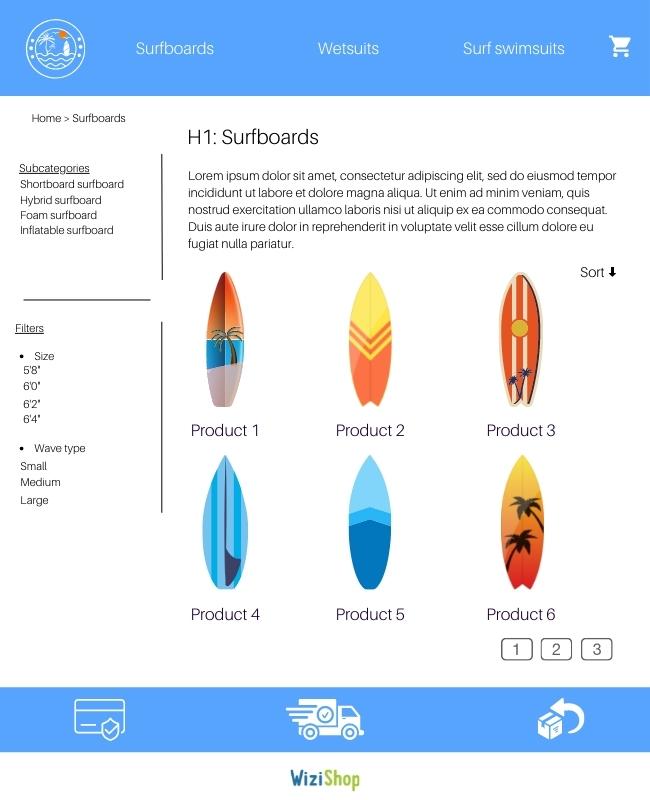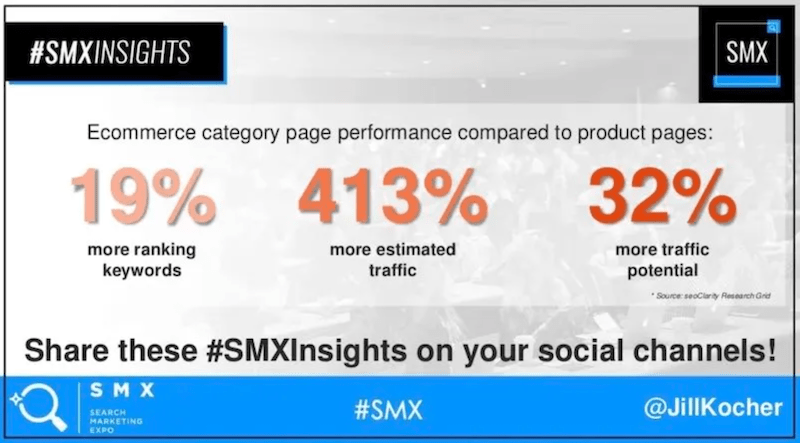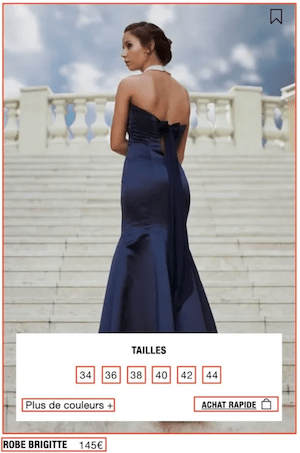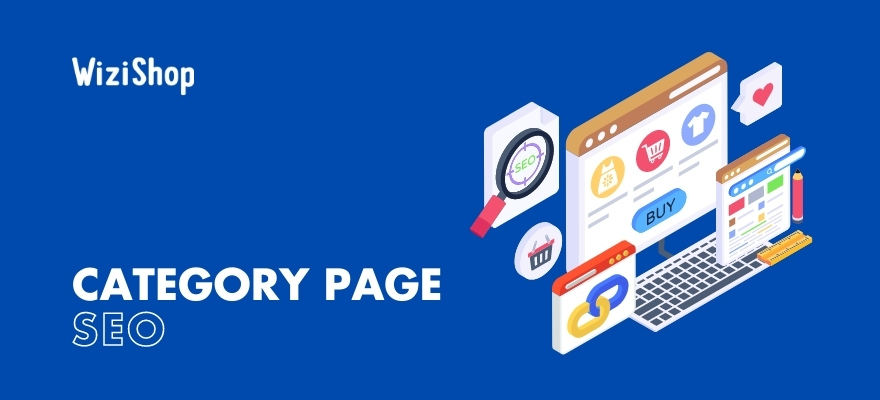In ecommerce, category pages are true pillars. They make navigation as fluid as possible while guaranteeing an optimal user experience. This is where the user consults your catalog, before going to the product page and finalizing their purchase.
These are also key pages in SEO. Often highlighted, they receive many internal links, which makes them particularly powerful when you want to rank for competitive keywords.
In this article, I’ll show you the importance of these pages and share with you the best practices to optimize the SEO of your ecommerce categories.
What is a category page on a website?
In ecommerce, category pages are listings that present the different products of your catalog, all classified by universe.

To illustrate, category pages are similar to the shelves of a store. If I stay with the surfing example that I often use in SEO articles, imagine yourself in a store dedicated to this water sport.
This kind of store offers many products in the surfing world: boards, wetsuits, booties, swimsuits, UV protection, towels, and ponchos. Each product is stored in the appropriate department.
In some departments, different product lines are offered. For example, in the surfboard department, you have shortboard, hybrid, fish, and longboard. In the wetsuit department, everything will be classified by gender (girl, boy, woman, man) or type (long and short).
In ecommerce, it’s exactly the same. The store’s departments are represented by categories. The sections within each department are represented by the subcategories.
They allow you to classify products efficiently. They’re an essential part of the structures of sites and allow users to navigate more easily.
To use the example of the water sports store, the category pages would be: “surfboards,” “wetsuits,” “surf swimsuits”... and the subcategories “shortboard,” “hybrid surfboard,” “girl surf suit,” “boy surf suit”...
Why optimize the SEO of ecommerce category pages?
As you’ll have understood, the category pages are the most powerful pages on your ecommerce site. They must be at the heart of your ecommerce SEO strategy.
Pages that generate more traffic
A recent study presented at SMX 2020 showed that categories are excellent pages to prioritize to drive traffic to your online store.

Source: SlideShare
This study of 30 leading U.S. e-tailers found that category pages outperformed product pages in keyword rankings and traffic.
Compared to product pages, the category pages in this study had the following:
- 19% more keywords positioned,
- 413% more estimated additional traffic, and
- 32% more potential traffic by implementing SEO optimizations.
This traffic is explained by the fact that these pages are at the top of the funnel. They are quite powerful and are positioned on very high volume keywords.
Powerful pages to target high volume keywords
Within the structures of ecommerce sites, category pages are strongly favored. Via the menu, the categories, or the products of the category concerned, this kind of page receives a very large number of internal links.
This power allows them to position themselves on competitive keywords and is very beneficial for SEO.
Central pages for robots’ crawls
The large number of links pointing to the categories make these pages real hubs for search engine robots.
This location allows them to discover the different products offered in your catalog and the associated categories through your internal linking.
Important pages for the internet user
I’m talking a lot about SEO because that’s the objective of this article, but the category pages are also extremely important for the people who visit your site. They’re even essential.
They allow you to classify your products into different groups and universes, which makes navigation more fluid and pleasant. They’re an invaluable aid to intuitively access the items you are looking for and to promote conversion on your online store.
Category pages are also a great way to get an overview of the products you have on your site.
How do you write and optimize SEO for category pages?
Now that you’re aware of the importance of category pages on your ecommerce site, here are the different SEO optimizations to implement to take advantage of their full potential!
Search for the relevant keyword
Like most of the pages on your site, the implementation of an SEO strategy on your category pages necessarily involves a preliminary search for keywords on Google.
One of the first steps in the optimization or creation of your category page will be to target a relevant keyword. By relevance, I mean that your category must have the objective of positioning itself on a keyword that has the following:
- Interest: check that the keyword is typed by internet users and has a certain search volume.
- A suitable level of competition: check that the keyword is accessible to have a chance of ranking ahead of competitors.
- A transactional search intent: check that the search results display ecommerce site category pages.
You can also check out our full article that lists different keyword research tools to complete your keyword research.
Respect the hierarchy
When you create and add a category within your site, you must respect a certain hierarchy within your tree structure. Your category and subcategory pages must be logical and consistent with each other.
Let’s return to our surfing equipment example. You will have a main category dedicated to surfboards. This category will be divided into other subcategories: shortboard, hybrid surfboard, fish surfboard, etc.
The structure frequently used in ecommerce to set up a hierarchical order on your site is the silo version. It’s presented in detail in our article on internal linking.

It consists of respecting the gradualness of the subjects (always go from the broadest to the most precise) to place your category in the right place on your site.
When structuring your site, it’s therefore imperative to avoid “catch-all” categories. Prioritizing a site is a question of balance!
Organizing your categories is a time-consuming task. Everything must be done in a thoughtful way. Nevertheless, it’s worth the effort...
Well-organized category pages considerably increase the time spent by each visitor on your pages, promote internal linking, and facilitate the path of search engine robots on your site.
SEO basics
As for the other pages of ecommerce sites, the category pages don’t deviate from the rule of SEO basics.
- Title tag: title that’s displayed directly in search results

To write it well, you must insert your keyword at the beginning and respect a maximum of about 65 characters. This tag must also be striking to encourage people to visit your page.
Discover our complete article on the title tag.
- Meta description tag: short summary that appears directly in the search results

Discover our complete article on the meta description.
- Hn tags: titles and subtitles that are displayed directly on the page
The structure of your page is highlighted by what are called Hn tags. These are all H1, H2, H3, etc. tags. They have a certain SEO weight and allow you to organize the content of your page.
In ecommerce, it’s common to see Hn tags on all product names present in the listing. There’s no real good or bad practice here, both can work. But in some cases, this can lead to a strong repetition of certain keywords in the Hn structure and have negative effects.
On the WiziShop ecommerce solution, we’ve chosen to place the product names in a <p> tag. You can therefore create your own Hn structure.
Discover our complete guides on the H1 tag and heading tags.
- URL: page address
Most of the time, your CMS automatically generates the URL of your category page by retrieving your title. I advise you to customize and optimize it. Here are the best practices:
- Use a short and concise format.
- Describe the category.
- Include your main keyword.
- Do not include linking words.
Discover our complete article on URL structure.
- Alternative texts for images: short presentation of an image
The alternative text, or Alt attribute, is an element that allows you to provide a short description of an image. The category page contains many visuals, so it’s advantageous to fill in this attribute for each of them.
Here are the best practices:
- Describe the visual.
- Use a short format of about 3 to 10 words.
- Make it unique for each image.
Discover our complete article on the Alt attribute.
Content
Your category pages should not only contain titles and product names.
To make the most of their power, you’ll need to add content to contextualize the page, improve SEO, and make it easier for search engine robots to understand.
- Content placement
The placement of your content will depend on your template. It can be at the top of the page, on the side, or below the product listing. It can also be in several places at once.
You can also hide part of the content with “Read more” tags, also called accordion. When you set up this display, I advise you to check that Google has the ability to analyze your text.
On the WiziShop ecommerce solution, you can add text for all your categories. The placement of the content area is different depending on the template. We also bring up the text of the categories in the code via CSS flex to make sure that it’s the first element that search engine robots discover.
- Number of words
Here again, it’s all about balance... John Mueller from Google was recently asked about the amount of content recommended in an ecommerce category page. He explained that a little bit of content is always useful, but you shouldn’t overdo it either. He also said that you shouldn’t turn your category page into a regular type of article. Why not? According to him, integrating too much content dilutes the value of category pages.
The objective of the content of the category pages is to provide context, without drowning out the essential elements. I therefore advise you to write texts of about 300 words.
Of course, in SEO, one answer that will often come back is the famous “it depends.” If you see that the first 10 results on your target keyword display a content of 800 words, then you may be tempted to do the same, and that’s normal. This recommendation should therefore be adapted.
- Type of content
I recommend that you focus the content of the categories on purely commercial text, highlighting your offer and your products: specificities, characteristics, advantages, types of use, user reviews, etc.
Avoid informational phrases such as “what is a surfboard”; save this type of content for your blog instead. This text should be beneficial for users by providing them with additional information.
Internal linking
As usual, internal linking is a key element for the SEO optimization and improvement of your category pages.
These pages often receive many internal links and also contain a number of them.
To ensure a logical order of navigation and to offer the most comfort possible to people visiting your online store, it’s necessary to integrate coherent and relevant links. As a general rule, they’ll point to your different categories and subcategories of the same universe and the products of your listing.
You can also insert internal links to shopping guides and blog articles, related to your category.
For example, for the “surfboard” category, I can insert a link to my “How to choose a surfboard” shopping guide. I can also add some links to blog posts like”"How to wax a surfboard” and “How to clean your surfboard.”
As soon as you have the opportunity on your site, it’ll be just as beneficial to link to your category.
For this part, I refer you again to our internal linking article which evokes the silo structure.
Technical aspects
In ecommerce, the technical lever is particularly important. A bad configuration of your store, and more precisely of your category pages, can lead to SEO problems.
- Pagination
Pagination is represented by the numbered pages that are created when you have a certain number of products in your category.

Badly managed, it can lead to crawling and indexing problems.
Here’s the configuration that we recommend and that is present on all WiziShop stores:
- From page 2+: Title tag de-optimized
- From page 2+: No H1
- From page 2+: No content to avoid duplicating the text on the 1st page
- Each paginated URL contains its own canonical tag
- Optimized numbering to access each page in 3 clicks maximum (see example above)
On WiziShop, you can also choose the number of products displayed per page. This number is 20 by default, but it can be between 5 and 100. This configuration allows you to reduce the pagination and the depth of the site and thus to facilitate the navigation of users and robots.
In general, the average number of products per page is about 48. The most important thing is to find the right balance between the number of products displayed and the loading time.
Discover our complete guide on pagination.
- Links to products
Your category listing often contains dozens of products. Each product represents an internal link.
Depending on the CMS you use, you may find yourself in a situation where your product contains multiple links to the same URL.

In this example of a product block in a category listing on a French site, each red square represents a link to the product page. That's about 10 links pointing to the same page. You can quickly imagine the number of useless internal links if you multiply by the number of products displayed.
On WiziShop, we work with a <div> system that allows us to encompass all the elements and have only one link per product.
- Sorting filters and facets
Sorting filters and faceted navigation are among the most problematic elements in SEO.
If not properly configured, they can generate thousands of low-quality pages, with meaningless internal links directly on the category page. This can cause crawling problems for search engine robots and have serious SEO consequences.
Once again, here’s the configuration that we recommend and that’s present on all WiziShop stores:
- Management via <button onclick> tags instead of the standard <a href> tag to prevent search engines from following filter links
- Presence of a noindex tag on each sort and facet page
In some cases, it can also be a good idea to open some filters to target long-tail keywords in SEO. We’re currently working on this subject to offer you this ability on WiziShop.
Category pages are essential to your business. They’re full of very beneficial SEO opportunities for your business and can help strengthen your organic marketing efforts.
You must therefore work on them effectively to guarantee an optimal user experience and high- performing SEO that allows you to rank higher on search engines like Google. Target the right keyword, optimize your different tags, add relevant content, check your technical elements, and reinforce everything with consistent internal linking!










